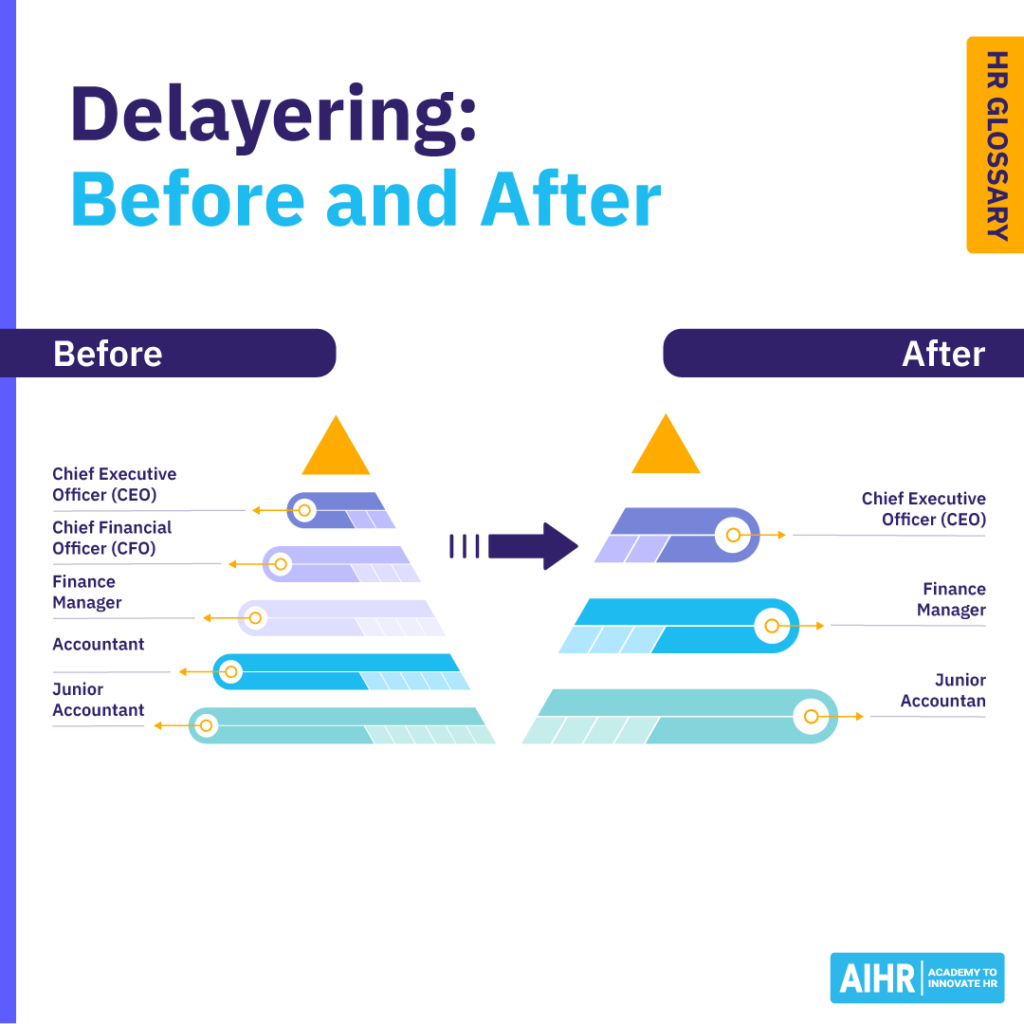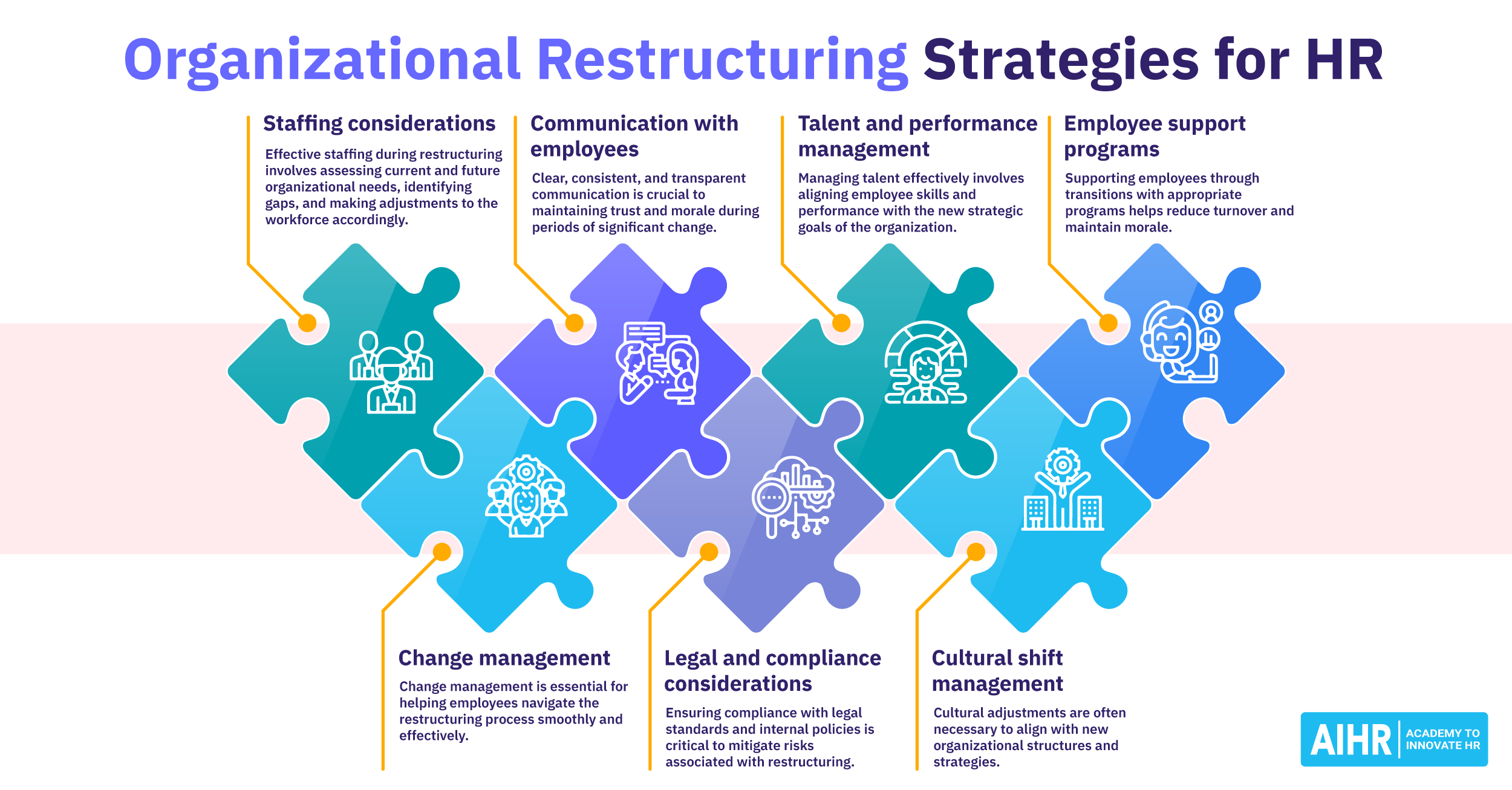Delayering
What is delayering?
Delayering is the process of reducing the number of management layers in an organization to create a flatter hierarchical structure. The method may involve removing middle managers, decentralizing decision-making, or merging similar functions and departments. The main goals of delayering are to improve operational efficiency, organizational agility, collaboration, and communication.
This practice is commonly used in larger organizations with complex structures, where too many layers can lead to inefficiencies. However, managing the change carefully is crucial to ensure employees aren’t overburdened with additional responsibilities after roles are consolidated.
HR plays a key role in organizational delayering, from identifying redundant management layers to overseeing change communication and adjusting compensation structures to fit the new model.
Downsizing vs. delayering
Here are some of the key differences between downsizing and delayering:
Definition
Reducing the number of management layers to create a flatter hierarchy.
Reducing the overall number of employees to cut costs or streamline operations.
Main goals
Improved communication, faster decision-making, enhanced agility.
Cost savings, increased efficiency, survival during financial challenges.
Employees impacted
Focus on removing middle management roles.
Can affect employees across all levels, not limited to management.
Potential negative consequences
Increased workload, reduced oversight, lack of career advancement opportunities.
Job loss and reduced productivity, morale, and innovation.
Examples of actions taken
Removing middle management, merging departments, redistributing responsibilities.
Layoffs, voluntary severance, early retirement incentives.
Advantages and disadvantages of delayering
Like most organizational processes that involve restructuring, delayering has benefits and downsides. These include:
Advantages
- Faster decision-making: With fewer managerial layers, key decisions can be made quicker, reducing delays and increasing agility to enable faster response to changes.
- Cost savings: Reducing the number of managers or merging functions and departments can significantly lower payroll and overhead costs.
- Increased employee autonomy: With reduced managerial input, employees may gain more control and responsibility over their work.
- Better communication: Fewer hierarchy levels typically result in more transparent and streamlined communication. Employees also have the opportunity to communicate directly with decision-makers.
- Cultural shift toward openness: Delayering can foster a less hierarchical, more open culture where employees feel closer to leadership and more engaged in the organization’s direction.
Disadvantages
- Risk of overloading managers: The remaining managers may have to assume broader control and oversee more direct reports, which can lead to managerial burnout and less effective supervision.
- Employee uncertainty: Those with restructured roles or responsibilities may experience anxiety adjusting to their new positions, or uncertainty about their future career paths in the organization.
- Initial period of lower productivity: Removing managerial layers may cause an initial period of disruption, lowering overall productivity as employees adjust to the new organizational structure.
- Not suitable for all organizations: Delayering may not work well if an organization does not have a workforce prepared to take on more responsibilities or work without direct managerial guidance.
- Widen skills gaps: If not properly planned, the delayering process may result in a loss of valuable skills and expertise from the loss of certain managers in their roles.
Examples of delayering
Example 1: General Electric
Former GE CEO Jack Welch was well known for his efforts to flatten the organization’s hierarchy. In the late 1980s and beyond, he sought to reduce the number of managerial layers at the corporate and business levels. According to one estimate, the company saved $40 million in administrative costs by removing top management layers. As a result of the delayering process, some key business sectors directly reported to Welch instead of to middle managers and supervisors.
Organizational delayering at GE significantly broadened managers’ responsibilities and the number of direct reports. Welch believed delayering improved decision-making. “I think people take more responsibility for their actions when they’re the last signature,” he said.
Example 2: Amazon
Amazon CEO Andy Jassy recently announced an initiative to reduce the company’s managerial layers. Amazon will aim to increase the ratio of individual contributors to managers by at least 15% by the end of Q1 2025. According to Jassy, the main goal of this initiative is for Amazon to “operate like the world’s largest startup”. Through the delayering process, Amazon seeks to increase agility, decrease bureaucracy, and enhance decision-making to improve the customer experience.

7 steps to implement an effective delayering process
Delayering implementation in your organization would depend on its unique needs and values. However, here are seven key steps you can take to implement an effective delayering process:
- Assess the current organizational structure: Start by assessing the existing hierarchy to identify redundancies and inefficiencies. This includes mapping out roles, responsibilities, and spans of control to pinpoint where layers could be removed without sacrificing functionality.
- Engage leadership and key stakeholders: Secure buy-in from top leadership and relevant department heads. Communicate the strategic purpose of delayering to ensure everyone understands how the changes will benefit the organization in terms of agility, communication, and cost-efficiency.
- Develop a clear change management plan: Delayering is a significant change, so HR should create a structured plan to manage it. This includes defining timelines, key milestones, communication strategies, and support resources for affected employees.
- Redefine roles and responsibilities: Once layers are removed, clearly outline new responsibilities and reporting structures. It’s essential to ensure each role is well-defined to prevent overlapping duties and gaps in accountability.
- Implement training and support programs: With broader spans of control and increased responsibilities, managers and employees may require upskilling or reskilling. Provide targeted training to prepare them for their new or expanded roles.
- Communicate transparently and regularly: Regular communication can ease concerns, especially since delayering often raises questions about job security and workload. Clearly explain the process, address employee questions, and update the organization on each phase’s progress.
- Evaluate the outcomes and refine the structure: Once delayering is implemented, track key metrics to assess its impact on efficiency, decision-making speed, and employee engagement. Gather feedback from employees and adjust the new structure as necessary.
HR tip
Before your organization initiates a widespread delayering initiative, consider conducting a test pilot with different teams or departments to determine employee readiness and get their feedback. Together with managers, HR teams can assess delayering pilot projects, focusing on whether employees have the right skills for cross-functional collaboration, effective decision-making, and adaptability to change.









